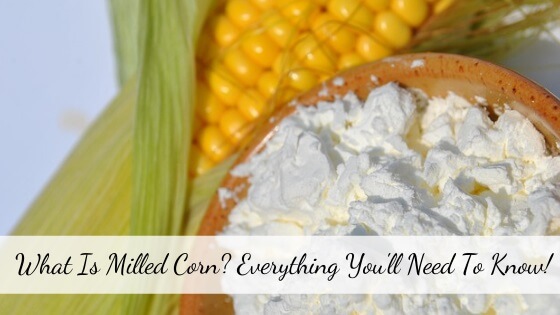New food and wellness culture trajectories can be pretty challenging to navigate with unfamiliar jargon, especially if you’re only starting to get into it.
So, if you keep seeing recipes that include milled corn and cannot figure out what that is, we’ve got you covered!
So, what is milled corn, you ask?
In simplest terms, it is the product of milling and processing raw maize (corn) to make it safe for consumption.
There are two main (and most common) ways of milling corn, and they are done through either machine milling, which is helpful for large-scale productions, and hand milling, which is optimal for smaller-scale productions or personal use.
Milled Corn has a wide variety of usage from the food industry to the textile.
Continue reading to learn everything you need to know about Milled Corn.
What Is Milled Corn? How is Corn Milled and Processed?
The process is lengthy, but it begins with simply cleaning the maize to ensure no impurities remain and you have solid maize kernels.
Any foreign substance such as dust, hay, or sand will degrade the final quality of the milled grain.
The cleaning process is also responsible for filtering out poisonous seeds and substances like metal or stones, which can cause damage to the milling equipment.
The next step is to condition the fresh kernels by adding moisture, making it easier for the bran to be peeled off smoothly when it is sifted.
The final milling can be done in several ways; roller mills are used for grinding, and they come in various types, including single, double, or pneumatic.
A maize milling company or plant will have several one’s working together simultaneously to produce more refined grains.
The grinding time generally depends on the desired final product, and sifters are used to separate cornflower and bran.
Wet-milling is the best method for milling corn because it yields potent results and extracts the most value from each kernel.
It is also the most capital intensive.
Big productions, companies, or plants opt for this method, while smaller productions opt for the less capital intensive method of dry-milling where kernels are hammer-milled to semi-fine grains.
As a try at-home experiment, you can mill corn at home using the AILIXI 700g Grain Mill Grinder with a high-speed electric, stainless-steel grinder.
Another excellent option is the Tall Cast Iron Mill grinder with a hand crank, manual for hand-milling grains, oats, corn, wheat, coffee, and nuts.
Why is Corn Milled?
Each kernel of corn has four major components: starch, fiber, protein, and oil.
The idea behind milling corn is to produce valuable materials by extracting any one of four of its major components.
The corn milling process may vary with what material needs to be removed, so the grinding time and amount of sifting may also vary.
Corn is an incredibly versatile raw source, and milling it produces (other than corn-based foods).
Dry-milling corn produces ethanol, and remains from the production are a highly potent source of protein for livestock.
Almost one-third of the grains produced from corn milling is used as a food source for livestock, which is equally essential for making high-quality eggs, meats, and poultry.
What is Milled Corn Used For?
Milled corn has multipurpose usage.
A single bushel of wet-milled corn can produce more than one and a half pounds of corn crude oil, thirteen pounds of corn gluten feed, and thirty-one pounds of starch.
It can be used for industrial starch purposes such as adhesives, cardboards, textiles, batteries, etc.
The use of industrial sweeteners such as acetic acids, dyes and inks, shampoos, etc., aren’t relatively uncommon.
It can also be used in industrial fermentation products such as organic solvents, chemicals, cosmetics, etc.
Other than its industrial usage, it is, of course, an essential component in foods.
Drugs such as aspirin contain wet-milled corn.
Baby foods, cereals, baked goods, candies, condiments, precooked processed meals, and many other products have milled corn as an ingredient.
Over four thousand items in any typical grocery store will have corn listed as one of its prime contents.
Wet-Milled Corn Vs Dry-Milled Corn
As mentioned earlier, the wet-milling process is designed to extract the highest value out of each kernel.
The process begins with soaking each large grain in an aqueous sulfur dioxide solution.
The softened kernel is then cleansed to remove germs, and high-value corn oil is extracted.
The remainder from germ oil extraction is sold as animal feed, and the remaining kernel products are distilled further to extract fiber to obtain corn gluten feed.
Starch is the last remaining component that is dried and modified to market to the textile, food, and paper industries.
The dry-milling process yields less versatile results and also requires significantly less capital.
It is primarily used to produce grain ethanol.
Is Milled Corn Good For You? :Milled Corn Dietary Factors
The type of food milled corn is used as a determinative factor for whether or not it will be healthy.
For example, milled corn is used in caramel coloring, but a high amount of caramel consumption is not ideal.
But the primary component of corn is a carbohydrate, fiber, and protein, meaning that it can be great for digestive health.
However, it is still rich in starch, which can cause a spike in blood sugar reduces the chances of weight loss.
Foods containing corn should be generally good for your health.
However, it is still essential to consider the modification process of milled corn and what other categories or compounds are present with milled corn in any one item because consumed in excess can cause concern.
If you would like to find out more about good corn-based / milled corn food options, here are a few of the better dietary choices:
Corn Oil
Fat content of corn oil is generally within 5 – 6%, making it an excellent low-fat choice.
Popcorn
Popcorn is a great snacking option because it packs a punch of vitamins and minerals, including zinc, copper, magnesium, manganese, and phosphorus.
Whole Grain Cereals
Most cereals contain a high amount of sugar and carbs, but whole grain cereals are lower on the scale, especially since corn is not a high glycemic food and falls lower on the glycemic index.
Check out this handy Kitchen Aid KGM All Metal Grain Mill Attachment for milling your corn from the comfort of your home.
You can grind low moisture grains from coarse to fine in a matter of minutes!
Is Milled Corn Gluten-Free?
Corn, in its natural form, is gluten-free and corn allergies are significantly rare.
Milled corn, however, is used in a wide variety of items containing different ingredients.
So, specific items or packaged food may contain gluten, but milled corn in itself is gluten-free.
What is Degermed Corn Meal?
Degermed corn meal is the food made from fully mature, sound, degermed kernels of corn.
It is cleaned from impurities, mould, seeds of weeds and other cereals through a grinding process.
In this process the grain is comminuted to a suitable degree of fineness from which bran and germ are take apart.
In corn the germ is high in oil and the oil easily goes rancid fast.
So, separating the germ from the other components helps to enhance the shelf life.
At the same time, you lose bit nutrients.
What’s the difference between Cornmeal and Corn flour?
The main difference between cornmeal and cornflour is the texture. Cornmeal is coarse and gritty having yellowish color.
Whereas corn flour is a fine powder and typically white in color.
Cornflour and cornmeal both are ground form of milled, dried corn.
The variation in texture comes from how coarsely or finely corns are ground.
Conclusion
It is easy to become overwhelmed by terminologies, especially if you understand what goes into your body.
But fear not, because now, from milling processes to types, benefits, and usage, you know all that there is to know about milled corn!
So, if you were looking at that milled corn cornbread recipe and wondering what milled corn was, well, now you know everything!
Sources:
https://www.healthline.com/nutrition/foods/corn#nutrients
https://blog.amg-eng.com/corn-wet-milling-vs-dry-milling/
https://www.iowacorn.org/education/corn-its-everything
Related Articles:



